List of extinct cetaceans
| Cetaceans Temporal range: Early Eocene - Recent | |
|---|---|
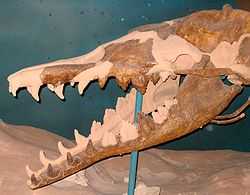 | |
| A skull of Basilosaurus cetoides. | |
| Scientific classification | |
| Kingdom: | Animalia |
| Phylum: | Chordata |
| Subphylum: | Vertebrata |
| Class: | Mammalia |
| Order: | Cetacea Brisson, 1762 |
The list of extinct cetaceans features the extinct genera and species of the order Cetacea. The cetaceans (whales, dolphins and porpoises) are descendants of land-living mammals, the even-toed ungulates. The earliest cetaceans were still hoofed-mammals. These early cetaceans became gradually better adapted for swimming than for walking on land, finally evolving into fully marine cetaceans.
This list currently includes only fossil genera and species. However, the Atlantic population of Gray Whales (Eschrichtius robustus) went extinct in the 18th century, and the Baiji (or Chinese River Dolphin, Lipotes vexillifer) was declared "functionally extinct" after an expedition in late 2006 failed to find any in the Yangtze River.
Suborder Archaeoceti
Family Ambulocetidae
(Eocene)
Family Basilosauridae
(Late Eocene)
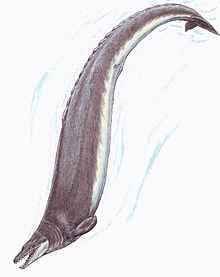
Family Kekenodontidae
(Oligocene)
- Kekenodon
- Phococetus
Family Pakicetidae
(Early to Middle Eocene)

Family Protocetidae
(Eocene)

- Georgiacetinae
- Babiacetus
- Carolinacetus
- Eocetus
- Georgiacetus
- Natchitochia
 Maiacetus skeleton
Maiacetus skeleton - Pappocetus
- Pontobasileus
- Makaracetinae
- Protocetinae
- Aegyptocetus
- Artiocetus[2]
- Crenatocetus
- Dhedacetus[3]
- Gaviacetus
- Indocetus
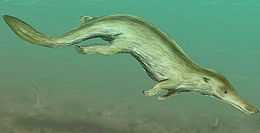 Kutchicetus minimus reconstruction
Kutchicetus minimus reconstruction - Kharodacetus[3]
- Maiacetus
- Protocetus
- Qaisracetus
- Rodhocetus
- Takracetus
- Togocetus[4]
Family Remingtonocetidae
(Eocene)
Suborder Mysticeti
Family Aetiocetidae
(Oligocene)
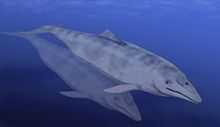
Family Llanocetidae
(Late Eocene)
Family Mammalodontidae
(jr synonym Janjucetidae)

(Late Oligocene)
Clade Chaeomysticeti
Superfamily Eomysticetoidea
Family Cetotheriopsidae
(Oligocene to Miocene)
- Cetotheriopsis
- Micromysticetus
Family Eomysticetidae
(Oligocene)
- Eomysticetus
- Tohoraata
- Yamatocetus
Superfamily Balaenoidea
Family Balaenidae
(Oligocene to Recent)
- Balaena
- Balaena affinis
- Balaena arcuata
- Balaena larteti
- Balaena macrocephalus
- Balaena montalionis
- Balaena ricei
- Balaenella
- Balaenotus
- Balaenula
- Eubalaena (extant)
- Eubalaena belgica
- Eubalaena shinshuensis
- Idiocetus
- Morenocetus
- Peripolocetus
- Protobalaena
Family Neobalaenidae
(Miocene to Recent)
Clade Thalassotherii
- Cetotheriomorphus
- Heterocetus
- Isocetus
- Mesocetus
- Notiocetus
- Palaeobalaena
- Rhegnopsis
Family Cetotheriidae
(Miocene - Recent)
Classification follows Steeman, 2007.[5]

- Brandtocetus
- Cephalotropis
- Cetotherium
- Eucetotherium
- Herentalia[6]
- Herpetocetus
- Hibacetus[7]
- Joumocetus[8]
- Kurdalagonus
- Metopocetus
- Mixocetus[9]
- Nannocetus
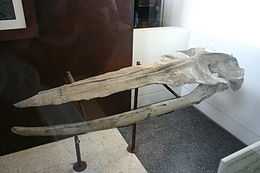 Parietobalaena palmeri skull
Parietobalaena palmeri skull - Otradnocetus
- Piscobalaena[10]
- Titanocetus[11]
- Vampalus
- Zygiocetus[12]
Superfamiliy Balaenopteroidea
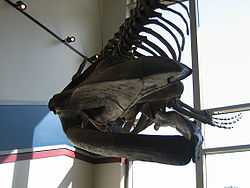
- Eobalaenoptera
- Mauicetus
- Tiphyocetus
Family Aglaocetidae
(Miocene to Pliocene)
- Aglaocetus
- Isanacetus
- Pinocetus
Family Balaenopteridae
(Oligocene to Recent)
- Archaebalaenoptera
- Balaenoptera (extant)
- "Balaenoptera" cortesii
- "Balaenoptera" portisi (synonym B. floridana)
- "Balaenoptera" ryani
- Burtinopsis
- Cetotheriophanes
- Parabalaenoptera
- Plesiobalaenoptera
- Plesiocetus
- Praemegaptera
- Protororqualus
Family Diorocetidae
(Miocene to Pliocene)
- Amphicetus
- Diorocetus
- Plesiocetopsis
- Thinocetus
- Uranocetus
Family Eschrichtiidae
(Miocene to Recent)
- Archaeschrichtius
- Eschrichtioides
- Gricetoides
- Megapteropsis
Family Pelocetidae
(Miocene)
- Cophocetus
- Halicetus
- Parietobalaena
- Pelocetus
Family incertae sedis
- Horopeta
- Imerocetus (Late Miocene; Chaeomysticeti)
- Mioceta (nomen dubium)
- Piscocetus (Pliocene; Chaeomysticeti)
- Siphonocetus (nomen dubium)
- Tretulias (nomen dubium)
- Ulias (nomen dubium)
Suborder Odontoceti
Basal forms
Family Agorophiidae
(Late Oligocene)
- Agorophius
Family Ashleycetidae
(Early Oligocene)
- Ashleycetus
Family Mirocetidae
(Early Oligocene)
- Mirocetus
Family Patriocetidae
(Oligocene to Early Miocene)
Family Simocetidae
(Late Oligocene)
Family Xenorophidae
(Oligocene)
- Albertocetus
- Archaeodelphis
- Cotylocara
- Xenorophus
Superfamily Squalodontoidea
Family Prosqualodontidae
(Oligocene to Miocene)
- Parasqualodon[14]
- Prosqualodon
Family Squalodontidae
(Oligocene to Pliocene)
- Eosqualodon
- Macrophoca
- Pachyodon
- Phoberodon
- Squalodon (syn. Kelloggia, Rhizoprion, Crenidelphinus, Arionius, Phocodon)
- Smilocamptus
- Tangaroasaurus
Family Waipatiidae
(Oligocene)
- ?Microcetus
- Otekaikea[15]
- ?Sachalinocetus
- Sulakocetus
- Waipatia
Superfamily Physeteroidea
Family Kogiidae
(Miocene to recent)
- Aprixokogia
- Kogia (extant)
- Kogia pusilla
- Nanokogia
- Praekogia
- Scaphokogia
- Thalassocetus
Family Physeteridae
- Aulophyseter
- Diaphorocetus
- Ferecetotherium
- Idiophyseter
- Idiorophus
- Orycterocetus
- Physeter (extant)
- Physeter antiquus
- Physeter vetus
- Physeterula
- Placoziphius
- Preaulophyseter
Family incertae sedis
- Acrophyseter
- Brygmophyseter
- Eudelphis
- Helvicetus (nomen dubium)
- Hoplocetus (nomen dubium)
- Kogiopsis
- Livyatan[16]
- Miokogia (nomen dubium)
- Paleophoca (nomen dubium)
- Placoziphius
- Prophyseter (nomen dubium)
- Scaldicetus (nomen dubium)
- Zygophyseter
Superfamily "Eurhinodelphinoidea"
Family Argyrocetidae
(Late Oligocene to Early Miocene)
- Argyrocetus
- Chilcacetus
- Macrodelphinus
Family Eoplatanistidae
(Miocene)
- Eoplatanista
Family Eurhinodelphinidae
(Mid Miocene to Pliocene)
- Ceterhinops
- Eurhinodelphis
- Iniopsis
- Mycteriacetus
- Phocaenopsis
- Schizodelphis
- Vanbreenia
- Xiphiacetus
- Ziphiodelphis
Superfamily Platanistoidea
Family Allodelphinidae
(Early to Middle Miocene)
- Allodelphis
- Zarhinocetus
Family Dalpiazinidae
(Late Oligocene to Miocene)
- Dalpiazina
Family Platanistidae
(Miocene to Recent)
- Araeodelphis
- Pachyacanthus
- Pomatodelphis
- Prepomatodelphis
- Zarhachis
Family Squalodelphinidae
(Early to Late Miocene)
- Huaridelphis[17]
- Medocinia
- Notocetus (syn. Argyrodelphis, Diochotichus)
- Phocageneus
- Squalodelphis
Superfamily Ziphioidea
Family Squaloziphiidae
(Early Miocene)
- Squaloziphius
Family Ziphiidae
(Miocene to Recent)
Classification after Bianucci et al. 2013[18]
- Basal forms
- Aporotus
- Beneziphius
- Messapicetus
- Ninoziphius
- Notoziphius
- Ziphirostrum
- Subfamily Berardiinae
- Archaeoziphius
- Microberardius
- Subfamily Hyperoodontinae
- Africanacetus
- Ihlengesi
- Mesoplodon (extant)
- Mesoplodon slangkopi
- Mesoplodon tumidirostris
- Subfamily Ziphiinae
- Caviziphius
- Choneziphius
- Globicetus
- Imocetus
- Izikoziphius
- Tusciziphius
- Subfamily incertae sedis
- Anoplonassa
- Belemnoziphius
- Cetorhynchus
- Eboroziphius
- Khoikhoicetus
- Nazcacetus
- Nenga
- Pelycorhamphus
- Pterocetus
- Xhosacetus
Clade Delphinida
Superfamily Delphinoidea
Family Albireonidae
(Miocene to Pliocene)
- Albireo
Family Delphinidae
(Oligocene to Recent)
- Anacharsis
- Arimidelphis
- Astadelphis
- Australodelphis
- Delphinus (extant)
- Delphinus domeykoi
- Eodelphinus
- Etruridelphis
- Globicephala (extant)
- Globicephala etruriae
- Globicephala karsteni
- Hemisyntrachelus
- Lagenorhynchus (extant)
- Lagenorhynchus harmatuki
- Orcinus (extant)
- Orcinus citoniensis
- Orcinus paleorca
- Platalearostrum[19]
- Protoglobicephala
- Pseudorca (extant)
- Pseudorca yokoyamai
- Septidelphis[20]
- Stenella (extant)
- Stenella rayi
- Tursiops (extant)
- Tursiops osennae
Family Kentriodontidae
(Late Oligocene - Middle Miocene)

- Subfamily Kentriodontinae
- Genus Belonodelphis
- Genus Delphinodon
- Genus Incacetus
- Genus Kampholophos
- Genus Kentriodon
- Genus Macrokentriodon
- Genus Microphocaena
- Genus Rudicetus
- Genus Tagicetus
- Subfamily Lophocetinae
- Genus Hadrodelphis
- Genus Liolithax
- Genus Lophocetus
- Subfamily Pithanodelphininae
- Genus Atocetus
- Genus Leptodelphis
- Genus Pithanodelphis
- Genus Sarmatodelphis
- Genus Sophianacetus
Family Monodontidae
(Miocene to Pliocene)
- Bohaskaia
- Denebola
Family Odobenocetopsidae
(Pliocene)

Family Phocoenidae
(Miocene to Recent)
- Archaeophocaena
- Australithax
- Brabocetus
- Haborophocoena
- Lomacetus
- Loxolithax
- Miophocaena
- Numataphocoena
- Piscolithax
- Pterophocaena
- Salumiphocaena
- Semirostrum[21]
- Septemtriocetus
Family incertae sedis
- Delphinavus
- Graamocetus
- Lamprolithax
- Miodelphis
- Nannolithax
- Oedolithax
- Oligodelphis
- Palaeophocaena
- Platylithax
- Prionodelphis
- Protodelphinus
- Sinanodelphis
Superfamily Inioidea
Family Iniidae
- Goniodelphis
- Hesperoinia
- Ischyrorhynchus
- Meherrinia
- Saurocetes
Family Pontoporiidae
(Middle Miocene to Recent)
- Auroracetus
- Brachydelphis
- Pliopontos
- Pontistes
- Protophocaena
- Stenasodelphis
Superfamily Lipotoidea
Family Lipotidae
(Miocene to Recent)
Family incertae sedis
- Agriocetus
- Atropatenocetus (Oligocene)
- Austrosqualodon (Oligocene)
- Hesperocetus
- Imerodelphis (Miocene)
- Kharthlidelphis
- Lonchodelphis
- Microsqualodon
- Microzeuglodon
- Neosqualodon
- Papahu (Miocene)[22]
- Pelodelphis
- Rhabdosteus (nomen dubium)
- Saurocetus (Oligocene)
See also
- Evolution of cetaceans
- List of cetaceans
- List of prehistoric mammals
- List of extinct animals
References
- ↑ http://deepblue.lib.umich.edu/bitstream/2027.42/57499/1/Vol%2031%20No%2013%20final%2012-19-07.pdf
- ↑ Gingerich, P.D. et al. 2001. Origin of Whales from Early Artiodactyls: Hands and Feet of Eocene Protocetidae from Pakistan. (19 September 2001). Science doi:10.1126/science.1063902.
- ↑ 3.0 3.1 Sunil Bajpai and J.G.M. Thewissen (2014). "Protocetid cetaceans (Mammalia) from the Eocene of India". Palaeontologia Electronica 17 (3): Article number 17.3.34A.
- ↑ Philip D. Gingerich and Henri Cappetta (2014). "A New Archaeocete and Other Marine Mammals (Cetacea and Sirenia) from Lower Middle Eocene Phosphate Deposits of Togo". Journal of Paleontology 88 (1): 109–129. doi:10.1666/13-040.
- ↑ M. E. Steeman (2007). "Cladistic analysis and a revised classification of fossil and recent mysticetes". Zoological Journal of the Linnean Society 150 (4): 875–894. doi:10.1111/j.1096-3642.2007.00313.x.
- ↑ M. Bisconti. 2014. Anatomy of a new cetotheriid genus and species from the Miocene of Herentals, Belgium, and the phylogenetic and palaeobiogeographical relationships of Cetotheriidae s.s. (Mammalia, Cetacea, Mysticeti). Journal of Systematic Palaeontology
- ↑ Otsuka, H.; Ota, Y. (2008). "Cetotheres from the early Middle Miocene Bihoku Group in Shobara District, Hiroshima Prefecture, West Japan". Miscellaneous Reports of the Hiwa Museum for Natural History 49 (2): 1–66.
- ↑ Kimura, T.; Hasegawa, Y. (2010). "A new baleen whale (Mysticeti: Cetotheriidae) from the earliest late Miocene of Japan and a reconsideration of the phylogeny of cetotheres.". Journal of Vertebrate Paleontology 30 (2): 577–591. doi:10.1080/02724631003621912.
- ↑ Kellogg, R. (1934). "A new cetothere from the Modelo Formation at Los Angeles, California.". Carnegie Institution of Washington 447: 83–104.
- ↑ Bouetel, V.; Muizon, C. de (2006). pdf "The anatomy and relationships of Piscobalaena nana (Cetacea, Mysticeti), a Cetotheriidae s.s. from the early Pliocene of Peru." (PDF). Geodiversitas 28 (2): 319–395.
- ↑ Bisconti, M. (2006). "Titanocetus, a new baleen whale from the middle Miocene of northern Italy (Mammalia, Cetacea, Mysticeti).". Journal of Vertebrate Paleontology 26 (2): 344–354. doi:10.1671/0272-4634(2006)26[344:tanbwf]2.0.co;2. JSTOR 4524574.
- ↑ K. K. Tarasenko (2014). "Novye rody usatykh kitov (Cetacea, Mammalia) iz miotsena Severnogo Kavkaza i Predkavkaz'ya. 3. Zygiocetus gen. nov. (srednii sarmat, Adygeya)". Paleontological Journal 48 (5).
- ↑ Robert W. Boessenecker (2013). "A new marine vertebrate assemblage from the Late Neogene Purisima Formation in Central California, part II: Pinnipeds and Cetaceans". Geodiversitas 35 (4): 815–940. doi:10.5252/g2013n4a5.
- ↑ Fitzgerald, E.M.G. 2004. A review of the Tertiary fossil Cetacea (Mammalia) localities in Australia. Memoirs of Museum Victoria 61(2): 183-208.
- ↑ Yoshihiro Tanaka and R. Ewan Fordyce (2014). "Fossil Dolphin Otekaikea marplesi (Latest Oligocene, New Zealand) Expands the Morphological and Taxonomic Diversity of Oligocene Cetaceans". PLoS ONE 9 (9): e107972. doi:10.1371/journal.pone.0107972.
- ↑ Lambert, O., G. Bianucci, K. Post, C. de Muizon, R. Salas-Gismondi, M. Urbina & J. Reumer. (2010). The giant bite of a new raptorial sperm whale from the Miocene epoch of Peru. Nature 466: 105–108. doi:10.1038/nature09067
- ↑ Olivier Lambert, Giovanni Bianucci, Mario Urbina, 2014. Huaridelphis raimondii, a new early Miocene Squalodelphinidae (Cetacea, Odontoceti) from the Chilcatay Formation, Peru. Journal of Vertebrate Paleontology 34 (5):987-1004.
- ↑ O. Lambert, C. Muizon, and G. Bianucci. 2013. The most basal beaked whale Ninoziphius platyrostris Muizon, 1983: clues on the evolutionary history of the family Ziphiidae (Cetacea: Odontoceti). Zoological Journal of the Linnean Society 167:569-598
- ↑ Klaas Post & Erwin J.O. Kompanje (2010). "A new dolphin (Cetacea, Delphinidae) from the Plio-Pleistocene of the North Sea". Deinsea 14: 1–13. ISSN 0923-9308.
- ↑ Giovanni Bianucci (2013). "Septidelphis morii, n. gen. et sp., from the Pliocene of Italy: new evidence of the explosive radiation of true dolphins (Odontoceti, Delphinidae)". Journal of Vertebrate Paleontology 33 (3): 722–740. doi:10.1080/02724634.2013.744757.
- ↑ Rachel A. Racicot, Thomas A. Deméré, Brian L. Beatty, Robert W. Boessenecker. Unique Feeding Morphology in a New Prognathous Extinct Porpoise from the Pliocene of California. Current Biology, 13 March 2014 DOI: 10.1016/j.cub.2014.02.031
- ↑ Gabriel Aguirre-Fernández and R. Ewan Fordyce (2014). "Papahu taitapu, gen. et sp. nov., an early Miocene stem odontocete (Cetacea) from New Zealand". Journal of Vertebrate Paleontology 34 (1): 195–210. doi:10.1080/02724634.2013.799069.

